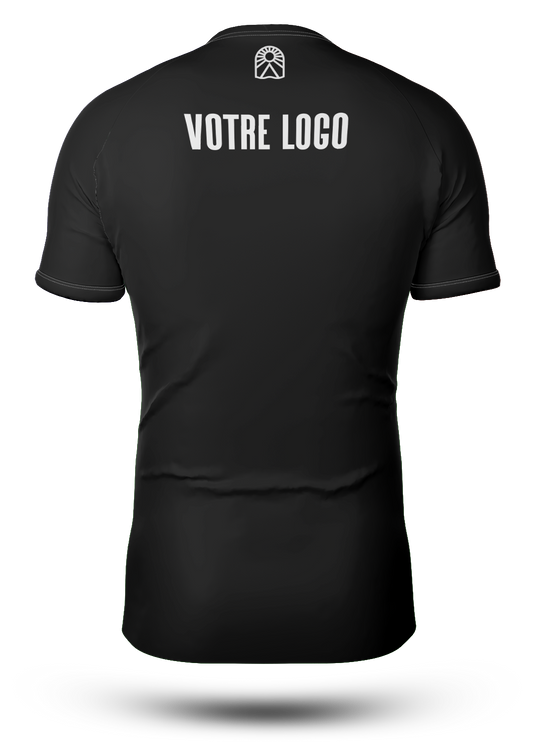
Top 10 Most Commonly Used Submissions in Jiu Jitsu
Pascal CadoretteHere are the 10 most commonly used submissions in Brazilian Jiu Jitsu!
Well, here you are, a Jiu Jitsu practitioner looking to improve your game, your attacks and your submissions . It's time to tackle the subject that makes every practitioner's heart beat faster: submissions.
You probably already know that these little gems of techniques can turn a simple workout into a resounding victory on the mat. But have you ever wondered which submissions are in the top 10, the ones that everyone uses and are super effective?
As Jiu Jitsu practitioners, we understand that it is an endless learning journey. You have already mastered the basics, acquired positions and started to find your style. If you have not already done so and are just starting out, then you can find our guide on Everything you need to know when starting out in Jiu Jitsu .
But now, let's get down to business. You're ready for the submissions that will make you shine, whether you're on the mat, in competition or simply teasing your friends.
In this article, we explore together the “10 most commonly used submissions in Jiu Jitsu” . In this article, we will dissect these techniques, give you practical tips, and help you integrate them into your repertoire. Whether you are a regular on the mat or you are new to Jiu Jitsu, there is always something new to learn.
Submission 1 : The Rear Choke (Rear Naked Choke)
The Rear Naked Choke, also known as the Rear Naked Choke , is one of the most fearsome and iconic submissions in Jiu Jitsu. This technique is often used to achieve a submission victory by putting the opponent in a desperate (and extremely difficult to escape!) position.
Description of the technique:
- To perform the rear-naked choke, start by taking your opponent's back. You should be positioned behind him.
- By reaching one arm over your opponent's shoulders, wrap your bicep and forearm around his neck and place your hand on your opposite shoulder.
- Use your other arm to reach behind the opponent's head and grab your own opposite shoulder.
- Squeeze your arms against your opponent's neck by flexing your forearms and pushing your chest forward to create two opposing forces against your opponent's neck.
- Once the hold is in place, your opponent will quickly be forced to tap out or pass out to avoid a full choke.
Tips for performing the rear choke correctly:
- Be patient and wait for the right moment to attempt the submission . It is most effective when your opponent is tired or off balance.
- Make sure you have good control of your opponent's rear to prevent him from escaping.
- Keep your arms tight to maximize pressure on your opponent's neck.
The rear naked choke is an extremely effective technique that can end a fight in an instant. It is an effective yet stealthy submission often used by Jiu Jitsu practitioners to secure victory. However, mastering it takes time and practice, but once you have it in your arsenal, it can become one of your best weapons on the mat.
Many beginners will be eager to pass this submission, as it is spectacular to succeed. But it can get you into a very big mess, if you are in too much of a hurry and make costly mistakes.
Submission 2 : The arm lock (Armbar)
The Armbar , or armlock, is one of the most versatile and formidable submissions in Jiu Jitsu. It allows you to control and submit an opponent by immobilizing their arm in a painful and restrictive manner.
Description of the technique:
- To perform the armbar, start by positioning yourself next to your opponent, maintaining control of their arm.
- Place one of your legs over your opponent's face and torso while grabbing his arm and keeping it perpendicular to the ground.
- Lower your hips towards your opponent's arm while maintaining pressure on their head with your leg.
- With your hands, grab your opponent's wrist and bend his arm in the direction opposite his elbow.
- Your opponent will quickly be forced to tap or risk arm injury.
Tips for performing the armbar correctly:
- Make sure to maintain solid control over your opponent's arm throughout the technique.
- Keep your body properly aligned to avoid losing your balance.
- Be aware of your opponent's reaction and adjust the pressure accordingly.
The armbar is a great submission hold to attempt. Its versatility makes it a favorite among Jiu Jitsu practitioners. It requires a certain amount of agility to not lose control over your opponent and some technique and understanding of arm mechanics, but once you master it, it becomes a powerful weapon in your arsenal.
Submission 3 : The Arm Wrench (Kimura)
The Kimura is an extremely versatile and formidable submission in Jiu Jitsu. It involves a painful twisting of the opponent's arm and provides several opportunities to submit. It is an excellent technique that requires very little technical knowledge, just a good stable position and good control of your opponent's wrist and arm.
Description of the technique:
- To perform the Kimura, start by positioning yourself on your opponent's side, controlling their opposite arm.
- Grab your opponent's wrist and bend his arm behind his back.
- Use your other hand to grab his forearm, creating an "L" shaped armlock.
- Apply gentle but steady pressure by lifting his elbow while maintaining control of his wrist.
- Your opponent will quickly be forced to tap or risk arm injury.
Tips for performing Kimura correctly:
- Make sure you have firm control over your opponent's arm and maintain a stable position.
- Avoid moving too far away from your opponent, as this could allow your opponent to escape.
- Pay attention to your opponent's reaction and adapt your pressure accordingly.
The Kimura is a very effective submission because of its versatility and ability to be applied from a variety of positions. It requires technique and understanding, but once mastered, it can become a powerful tool to dominate your opponents on the mat.
Submission 4 : Triangle Choke
The Triangle Choke is an iconic submission hold in Jiu Jitsu. This technique is incredibly effective and versatile, as it can be applied from multiple positions and allows you to submit your opponent by using your legs to control their neck.
Description of the technique:
- To perform the Triangle Choke, start by being in a guard position with your opponent above you.
- Control one of his arms by pulling it towards you while putting your leg over his shoulder.
- With your leg, form a triangle around your opponent's neck by placing the ankle behind the opposite knee.
- Squeeze your thighs together to put pressure on your opponent's neck, while pulling on their head to reinforce the choke.
- Your opponent will quickly be forced to tap out or faint to avoid full choke.
Tips for performing the Triangle Choke correctly:
- Make sure you control your opponent's arm well to prevent him from defending himself.
- Constantly adjust the pressure by squeezing your thighs together to reinforce the constriction.
- Keep the hip on the side of the controlled arm slightly raised to maximize pressure.
The Triangle Choke is an extremely powerful submission that can be applied offensively or defensively. It requires good technique and an excellent understanding of balance and pressure.
Submission 5 : The guillotine (Guillotine Choke)
The Guillotine Choke is a classic submission in Jiu Jitsu, famous for its ability to quickly submit an opponent by compressing their windpipe. It’s a technique you’ve probably seen and even tried while sparring with people outside. This technique can be performed standing or on the ground, making it a versatile weapon for Jiu Jitsu practitioners.
Description of the technique:
- The Guillotine Choke can be performed in two main ways: standing or on the ground.
- For the Standing Guillotine, you start by grabbing your opponent's head by placing your arm around their neck.
- While on the ground, you can cast the Guillotine Choke from guard or while under your opponent.
- Either way, squeeze quickly by crossing your forearms to compress your opponent's trachea while using your hips to reinforce the pressure.
Tips for correctly performing the Guillotine Choke:
- From a standing position, use your arm to push down while maintaining the grip to prevent your opponent from lifting you.
- In a floor position, keep your body well aligned and your hips under control to maximize the pressure.
- Be quick and aggressive when applying to surprise your opponent.
The Guillotine Choke is a submission that can be executed quickly , making it effective in catching an opponent off guard. It requires good technique and quick reaction to be executed successfully.
Submission 6 : The Mata Leão (Anaconda Choke)
The Mata Leão, also known as the Anaconda Choke , is a fearsome submission in Jiu Jitsu. This technique is characterized by its powerful grip around the opponent's neck, which causes intense pressure on the trachea and arteries, thus forcing the submission .
Description of the technique:
- To perform the Mata Leão, start by being behind your opponent, ideally controlling his back.
- Place one arm under your opponent's neck, grabbing the bicep with the other arm.
- Use your other arm to grab the tricep of the arm that went under your opponent's neck.
- Bring your elbows together, creating a tight grip around your opponent's neck.
- Apply pressure by tightening your arms to force submission .
Tips for performing Mata Leão correctly:
- Make sure you have good control of your opponent's back to prevent him from escaping.
- Maintain constant pressure on your opponent's neck while avoiding releasing the hold.
- Pay attention to your opponent's reaction to adjust the pressure accordingly.
The Mata Leão is a formidable submission that can submit an opponent quickly and effectively. It requires good technique, good position control, and an understanding of submission mechanics. However, it is still fairly simple and quick to set up since there are few steps to complete it.
Submission 7 : The Brazilian Choke (Brabo Choke)
The Brazilian Choke, also known as the Brabo Choke , is a formidable submission in Jiu Jitsu that aims to control and submit the opponent by applying pressure to their neck and forcing them to give up.
Description of the technique:
- To perform the Brazilian Choke, start by being in a side control or mount position on your opponent.
- Use one of your arms to encircle your opponent's neck, going across the front of their neck.
- With your other arm, grab your opponent's arm on the opposite side, maintaining a firm grip.
- Apply pressure by bringing your elbow close to your opponent's neck, forcing him to give up.
Tips for performing the Brazilian Choke correctly:
- Make sure you have good control of the side position or mounted position to prevent your opponent from escaping.
- Squeeze your arms steadily to maintain pressure on your opponent's neck.
- Pay attention to your opponent's reaction to adjust the pressure accordingly.
The Brazilian Choke is an effective technique that can surprise and quickly submit an opponent. It requires a good understanding of position and technique, as well as quick reaction to capture the submission opportunity.
Submission 8 : The Cross Strangulation (Cross Collar Choke)
The Cross Collar Choke is a classic submission in Jiu Jitsu that takes advantage of your opponent's mastery of the lapels to apply pressure to his neck. This technique is formidable when executed well. It is also one of the first submissions that we learn as soon as we reach the white belt in jiu jitsu . Simple to perform, this submission in Jiu Jitsu can be done from several positions.
Description of the technique:
- To perform the Cross Choke, start by being in a mounted position on your opponent, controlling their upper torso area.
- Use your hands to grab your opponent's lapels (kimono collars), one on each side of their neck.
- Apply pressure by pulling your lapels outward while raising your elbows and stretching your opponent.
- This action compresses the sides of his neck, causing a strangulation sensation.
Tips for correctly performing the Cross Choke:
- Make sure you have firm control in the mounted position to prevent your opponent from knocking you over.
- Maintain constant pressure on the lapels to maximize the choke.
- Pay attention to your opponent's reaction to adjust the pressure accordingly.
The Cross Choke is an effective technique that takes advantage of the dominant mount position and the manipulation of the kimono lapels. It requires a good understanding of the mount position and good speed to surprise your opponent. Once mastered, it becomes a valuable weapon in a Jiu Jitsu practitioner's arsenal.
Submission 9 : The Ankle Key (Ankle Lock)
The Ankle Lock is a submission hold that targets the opponent's ankle to cause intense pain and force them to give up. While it is often used in barefoot combat, it can also be applied while wearing a gi, making it a versatile technique for Jiu Jitsu practitioners.
Description of the technique:
- To perform the Ankle Lock, start by positioning yourself next to your opponent, ideally controlling their ankle.
- Grab your opponent's ankle, placing your arm under his leg.
- Use your other hand to support the top of your opponent's foot.
- Apply pressure by flexing your opponent's ankle while elevating their toes.
- This action puts pressure on the tendons and joints of the ankle, causing pain.
Tips for performing the Ankle Wrench correctly:
- Make sure to maintain firm control over your opponent's ankle to prevent him from defending.
- Be sure to keep your body properly aligned to avoid losing your balance.
- Pay attention to your opponent's reaction and adjust the pressure accordingly.
The Ankle Lock is a formidable submission that can be applied to opponents of all sizes. It requires technique, patience, and an understanding of ankle mechanics. Once mastered, it becomes a powerful weapon in a Jiu Jitsu practitioner's arsenal.
Submission 10 : The Two-Armed Guillotine Choke (D'Arce Choke)
The Double Arm Guillotine Choke, also known as the D'Arce Choke , is a powerful submission in Jiu Jitsu that targets the opponent's neck using both arms to apply intense pressure. This technique is effective and deadly, making it a valuable asset in any Jiu Jitsu practitioner's arsenal.
Description of the technique:
- To perform the D'Arce Choke, start by standing to your opponent's side, controlling their head and arm.
- Use one of your arms to encircle your opponent's neck, going across the front of their neck.
- Pass your other arm under your opponent's arm, grabbing your own arm that is already around his neck.
- Apply pressure by squeezing your arms together while pushing your chest back.
- This action puts pressure on your opponent's neck, causing a chokehold.
Tips for correctly performing the D'Arce Choke:
- Make sure you have good control of your opponent's head and arm to prevent him from defending.
- Keep your body properly aligned to maintain balance and pressure.
- Pay attention to your opponent's reaction to adjust the pressure accordingly.
The D'Arce Choke is a powerful submission that can surprise and quickly submit an opponent. It requires technique, patience, and an understanding of choke mechanics. Once mastered, it becomes a valuable weapon in a Jiu Jitsu practitioner's arsenal.









